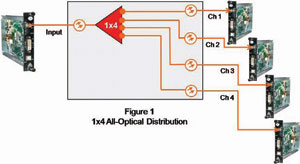EVOLUTION OF FIBER SYSTEMS IN THE AV MARKET
Advocates of the ‘all-optical’ network in the AV market will have to exercise patience, as this change in architecture will take time to become understood and gain acceptance in the AV market. There is hope, as it appears as though it is now rapidly taking hold, even while it is still generally considered to be a technology that is used to simply replace the existing, outdated copper infrastructure. Signal transmission over fiber is known as the technology that allows signals to be transmitted further and faster than copper. In many cases, this replacement argument is quite valid—especially in simple point-to-point links. The idea of sending and distributing many signals on a single fiber is just scratching the surface in this market.
The evolution of fiber systems will not necessarily occur with new electronic hardware for sending and receiving the increasingly-demanding high-performance signals but will, in fact, be observed in the fiber system designs and resulting infrastructure. Enabled by the optical and signal-agnostic characteristics of fiber, more complex electronic devices (transmitters and receivers) will also be developed but will not be the major reason for the increased complexity and functionality of fiber systems. DisplayPort is one technology that is gaining momentum as the pro-sumer version of HDMI and is being incorporated in many pro AV installations. It is expected that more fiber transmission equipment will be developed that will transport DisplayPort and other HD video signals over longer distances—particularly in applications such as videoconferencing and telepresence in the courtroom.
Figure 1: A typical 1x4 splitter that distributes an RGBHV or DVI signal and audio to four different locations.
The future of fiber relies on the fact that it is also a versatile transport network that can carry and distribute different types and quantities of signals to different destinations, all in the optical domain. A simple example of this would be the case where video and audio needs to be transmitted from one location and simultaneously distributed to multiple locations.
In a copper environment, the video signals would have to go through some type of signal-specific distribution amplifier and sent to each location. An equivalent fiber distribution system eliminates the need for the active distribution amplifiers and can transmit all of these signals over a single fiber. A simple optical splitter is used to split the light into multiple paths for further transmission to the various receiving locations with no loss of signal quality.
As the system demands change, possibly from RGB/DVI to HDSDI or DisplayPort this optical splitter design, being signal-agnostic, will still meet this need. If this were an electrical distribution amplifier, it would have to be changed to accommodate the new HDSDI signal, further increasing the cost and complexity of the system infrastructure.
Allowing for an adequate optical budget, this optical design can easily be extended to a 1x8 splitter design. An obvious extension of this splitter design is the four- and eight-channel optical switch. Using standard telecom-type optical switches, each of the outputs can be individually turned on and off, allowing the input signal to be easily routed to any one or all of the output ports.
These basic optical system components will be the basis for the growth of fiber in the AV market. The telecom industry has invented and taken advantage of these and many other optical system elements to create very unique and effective system designs. As part of the evolutionary process, it’s only a matter of time before the AV market adopts some of these components to develop its own creative fiber infrastructures.
The key to the future deployment of these systems is to ensure that the AV consultants, integrators, and others who design systems are aware of these components, understand their capabilities and advantages, and know how to utilize them to maximize their effectiveness. Only with this knowledge and understanding of these components’ capabilities will we start to design and deploy these evolutionary systems—reminiscent of the groundbreaking days of telecom systems.
FiberRoadmap
These optical splitter and wavelength-selective components are only a few of the elements that will help alter the future of fiber systems in the AV arena. Other components such as mission-critical fiber protection switches, fiber redundancy, and all-optical matrix switches are some other fiber components that will help the evolution of fiber transport AV systems. Instead of the philosophy of simply replacing copper with fiber, new versatile and functional fiber networks will start to emerge in the coming year or two.
Coarse Wavelength Division Multiplexing (CWDM): The AV market has already adapted CWDM to high-density, point-to-point signal transport systems. A logical extension of this architecture is the wavelength routing or switching systems. Using a type of CWDM filter, each of the wavelengths can be dropped or routed to various fixed-wavelength nodes.
Reconfigurable Optical Add-Drop Module (ROADM): The next level of wavelength system integration might be to incorporate a controlled wavelength switch at each of these drop locations. As with most optical components, the ROADM has its roots in the telecom market and plays an important role in metro and other telecom markets. The ROADM is basically a remote-controlled wavelength switch. It is unlikely that this component will see much use in the AV market in the coming year or two. However, it’s important to understand the various optical components and their uses in the equipment arsenal of the AV system designer.
Fiber redundancy or network protection: This is always a concern when dealing with a string-type of a network, particularly in mission-critical applications. Designers and installers will have to learn various ways to configure some level of fiber protection using optical elements and protection switches.
Ed Miskovic (emiskovic@meridian-tech.com) is EVP of sales and marketing for Meridian Technologies, and has more than 30 years of experience in the field of fiber optics system design, application engineering, education and training, and R&D.
